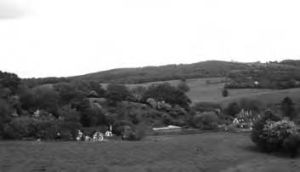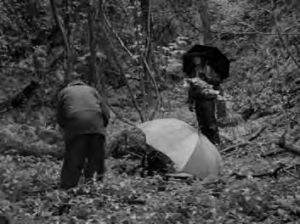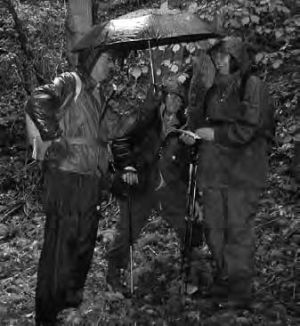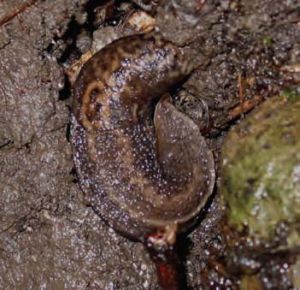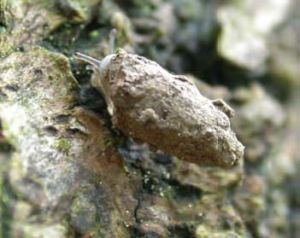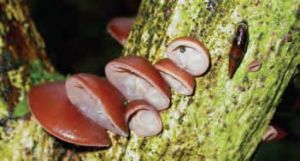|
When I arrived at the Suckley Hills the weather was quite dry – at least it was not actually raining although several inches of rain had fallen in the past few weeks. A good description of the woodland was ‘sopping wet’! Nevertheless a Pied Flycatcher sang from a nearby oak while I waited for the rest of the party and I was beguiled into taking an insect net with me in the hope that the flowering hawthorn would attract a few hoverflies and bees. The net was useful in finding one snail species despite the general wetness of the day punctuated at regular intervals by torrential downpours! Add to that great splodges of water falling from the trees when it was not raining, and the wind blew: it was a great day for testing umbrellas and waterproof clothing. My view that a naturalist should never be without an umbrella was reinforced once again! This part of west Worcestershire is situated on Silurian rocks and a glance at the geological map shows it to be an area of considerable complexity with a wide variety of shales and limestones. The first part of our itinerary was along woodland tracks and into a string of old quarries lying within Suckley Wood, a wooded ridge situated on Wenlock Limestones – the same as those out-cropping at Dudley Castle in West Midlands - and the associated Coalbrookdale formations. The Wenlock limestones are quite hard, fossil-rich, and have often been quarried. The second part of our visit was to follow the footpath along the nearby hilltop ridge within Hallhouse Wood lying about 500 metres to the west of Suckley Hills on the other side of a shallow valley. This ridge is formed of rocks of the Ludlow series and the ridge top is marked by a narrow out-cropping of Aymestry limestone consisting mainly of calcareous mudstones which appear not to have been quarried in the area. Suckley Wood is ancient semi-natural deciduous woodland which was partly coniferised 30-40 years ago. The conifers are gradually being cleared by the present owner and native woodland allowed to regenerate. Tree species include Small-leaved Lime, Wild Service and many Yew trees, and the site is floristically rich. Hallhouse Wood is also ancient semi-natural woodland but it has been more heavily coniferised and most of it is now managed as a conifer plantation. Small blocks of native woodland survive within it alongside the main public right of way and elsewhere. The list of mollusc species found on this visit to the two sites is attached. Generally the eastern Suckley Hills and Wenlock limestone quarries seem to support more species, although our search was more thorough there than in Hallhouse Wood. Several years previously we had briefly visited the quarries at the northern end of the Suckley Hills (Crews Hill Wood – a Worcestershire Wildlife Trust reserve) in very dry conditions and found little apart from a previously unrecorded colony of Pomatias elegans living amongst small zones of scree in the old quarries. On the present visit it was especially pleasing to find this species in similar habitat in all the old quarries on the Wenlock Limestone – a north-south strip about 2 km long. Perhaps the main feature of this field visit was that many molluscs were climbing trees! Besides the common tree climbers Clausilia bidentata and Cochlodina laminata and a variety of slugs, the surprise for me was to see many Ena obscura heading up tree trunks! Obviously the recent days of wet weather had encouraged lots of tree climbing activity and the contrast between this visit and the one in very dry conditions a few years ago when molluscs of all sorts were hard to find was very striking. I am not an expert conchologist and these field meetings always teach me something new. This time the first lesson was to find the thin, slender ‘Bert-the-gorilla’ slug Boetgerilla pallens and appreciate its general pallidity suffused in part with blue. Second was Ena obscura. I have never before seen so many in one day! I have long recognised that in the living state this is a dirty snail of leaf litter which usually has a shell coated with fine soil particles. However, when David Long pointed to a small object resembling a beetroot seed stuck to a tree trunk and said “… there’s a young Ena obscura” my first reaction was of disbelief! However, there it was: a snail a few millimetres long enrobed (as the chocolate makers say!) with quite large soil crumbs. The question I should like answered is – how does this camouflage get stuck to the shell? A snail could hardly roll in it! Presumably the shell is somehow coated with sticky mucus that attracts and retains soil particles? Next lesson again came from David Long. “It’s worth” he said “sweeping the outer branches of these old yew trees for Zenobiella subrufrescens”. So I swept through the branch tips with my sopping wet insect net and behold, amongst the spiders, harvestmen, inevitable small flies and craneflies, there they were, in both woods! Again, questions! Why do they do it? It’s a long way up a yew trunk and out to the branch tips. Is there worthwhile grazing there, if that is what this species does? Or are these sites simply safe refuges? The complex band of Silurian Woolhope, Wenlock and Ludlow limestones and associated strata runs roughly north-south from Ledbury along the west side of the Malvern Hills and continues north to within a few kilometres of Wyre Forest. There are many ancient woods and a few herb-rich grasslands in this zone. It strikes me as an area well worth more molluscan exploration and I shall be closely examining maps for sites to explore in the future. Both these wooded ridges are private property. They are traversed by public rights of way. We are grateful to Bob Steele for permission to visit Suckley Wood. |
Fig 1. Suckley Hills viewed from Hallhouse wood. Photo: Rosemary Hill
Fig 2. Field work in Suckley Hills quarry. Photo: Ron Boyce
Fig 3. It was a very wet day! Suckley Hills survey group. Left to right David Long, Ron Boyce, Rosemary Hill. Photo: Harry Green
Fig 4 Limax maximus in Suckley quarry. Photo Ron Boyce.
Fig 5 Ena obscura covered with soil. Photo Harry Green.
Fig 6 Jew’s ear fungus with Cochlodina laminata in Suckley Hills quarry. |
Molluscs found on the Suckley Hills,Worcestershire, 20th May 2006. Central grid reference SO734518. (L = live animal seen. Some were also seen as shells but this is not recorded in this list).
- Aegopinella nitidula L
- Aegopinella pura L
- Arion ater agg L
- Arion distinctus L
- Arion hortensis seg L
- Arion intermedius L
- Arion subfuscus L
- Boetgerilla pallens L
- Carychium tridentatum L
- Cepaea hortensis L
- Cepaea nemoralis L
- Clausilia bidentata
- Cochlicopa lubricella L
- Cochlodina laminata L
- Deroceras reticulatum L
- Discus rotundatus L
- Ena obscura L
- Helix aspersa L
- Limax maximus L
- Nesovitrea hammonis L
- Oxychilus alliarius L
- Oxychilus cellarius L
- Pomatias elegans L
- Punctum pygmaeum L
- Trichia hispida L
- Vitrea contracta L
- Zenobiella subrufescens L
Molluscs found at Hallhouse Wood, Worcestershire, 20th May 2006. Central grid reference SO730515. (L = live animal seen. Some were also seen as shells but this is not recorded in this list).
- Arion ater agg L
- Arion cf hortensis agg L
- Arion subfuscus L
- Cepaea hortensis L
- Clausilia bidentata L
- Cochlicopa lubricella L
- Cochlodina laminata L
- Deroceras reticulatum L
- Discus rotundatus L
- Ena obscura L
- Lehmannia marginata L
- Oxychilus cellarius L
- Trichia hispida L
- Zenobiella subrufescens L

